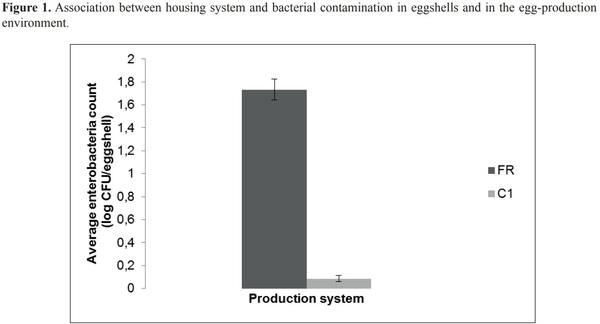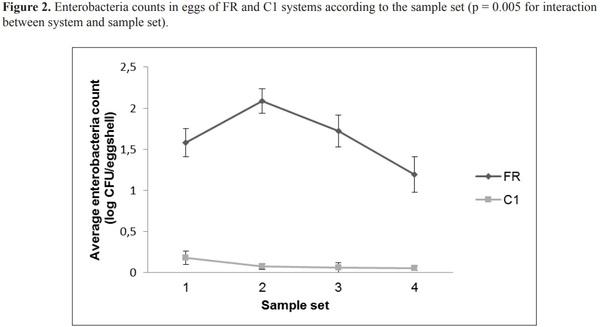Microbiological vulnerability of eggs and environmental conditions in conventional and free-range housing systems
Author details:



ANDREWS, W. H.; JACOBSON, A.; HAMMACK,
T. Salmonella. Bacterial analytical manual [on-line].
Silver Spring: Food and Drug Administration, 2011.
Chapter 5. Available at: <http://www.fda.gov/Food/
FoodScienceResearch/LaboratoryMethods/ucm070149. htm> Accessed at: 10 may. 2012.
BARROW, P. A.; JONES, M. A.; SMITH, A. L.;
WIGLEY, P. The long view: Salmonella the last forty years. Avian Pathology, London, v. 41, n. 5, p. 413-420,
2012.
BOUMART, Z.; ROCHE, S. M.; LALANDE, F.;
VIRLOGEUX-PAYANT, I.; HENNEQUET-ANTIER,
C.; MENANTEAU, P.; GABRIEL, I.; WEILL, F. X.;
VELGE, P.; CHEMALY, M. Heterogeneity of persistence of Salmonella enterica serotype Senftenberg strains could explain the emergence of this serotype in poultry flocks. PLoS One, San Francisco, v. 7, n. 4, p. 1-10, 2012.
BRADEN, C. R. Salmonella enterica serotype Enteritidis and eggs: a national epidemic in the United States.
Clinical Infectious Diseases, Chicago, v. 43, n. 4, p. 512-
517, 2006.
BRASIL. Instituto Brasileiro de Geografia e Estatística.
Indicadores. Estatística da Produção Pecuária. Ranking e variação anual da produção de ovos de galinha –
Unidades da Federação – Terceiro trimestre de 2016.
Brasília: IBGE, 2016. Disponível em: <ftp://ftp.ibge. gov.br/Producao_Pecuaria/Fasciculo_Indicadores IBGE/ abate-leite-couro-ovos_201603caderno.pdf>. Acesso em: 16 abr. 2017.
______. Ministério da Saúde. Secretaria de Vigilância em Saúde – SVS Departamento de Vigilância das
Doenças Transmissíveis. Coordenação Geral de Doenças
Transmissíveis. Unidade de Vigilância das Doenças de
Transmissão Hídrica e Alimentar. Doenças Transmitidas por alimentos. Brasília: Ministério da Saúde, 2013.
Disponível em: <http://www.saude.gov.br>. Acesso em:
19 set. 2013.
COLLARD, J. M.; BERTRAND, S.; DIERICK, K.;
GODARD, C.; WILDEMAUWE, C.; VERMEERSCH,
K.; DUCULOT, J.; VAN IMMERSEEL, F.; PASMANS,
F.; IMBERECHTS, H.; QUINET, C. Drastic decrease of
Salmonella Enteritidis isolated from humans in Belgium in 2005, shift in phage types and influence on food-borne outbreaks. Epidemiology and Infection, Cambridge, v.
136, n. 6, p. 771-781, 2008.
______. European Community. Commission Regulation (EC) No 1168/2006 of 31 July 2006 implementing regulation (EC) no 2160/2003 as regards a community target for the reduction of the prevalence of certain
Salmonella serotypes in laying hens of Gallus gallus and amending Regulation (EC) no 1003/2005. Official
Journal of the European Union. L211, v. 49, p. 4-9, 2006.
______. European Community. Commission Regulation (EC) no 2160/2003 of the European Parliament and of the Council of November 17, 2003 on the control of
Salmonella and other specified foodborne zoonotic agents. Official Journal of the European Union L325, v.
41, p. 1-15, 2003.
DE BOER, E.; WIT, B. Salmonella in eieren. Tijdschrift
Voor Diergeneeskunde, Amsterdam, v. 124, n. 4, p. 126-
127, 2000.
DE REU, K.; GRIJSPEERDT, K.; HEYNDRICKX, M.;
UYTTENDAELE, M.; HERMAN, L. The use of total aerobic and Gram-negative flora for quality assurance in the production chain of consumption eggs. Food Control,
Kidlington, v. 16, n. 2, p. 147-155, 2005.
DE REU, K.; RODENBURG, T. B.; GRIJSPEERDT, K.;
MESSENS, W.; HEYNDRICKX, M.; TUYTTENS, F. A.;
SONCK, B.; ZOONS, J.; HERMAN, L. Bacteriological contamination, dirt, and cracks of eggshells in furnished cages and noncage systems for laying hens: an international on-farm comparison. Poultry Science,
Oxford, v. 88, n. 11, p. 2442-2448, 2009.
DOHOO, I.; MARTIN, W.; STRYHN, H. Veterinary epidemiologic research. 2th ed. Prince Edward Island:
Atlantic Veterinary College Inc., University of Prince
Edward Island, 2010. 865 p.
ESAKI, H.; SHIMURA, K.; YAMAZAKI, Y.; EGUCHI,
M.; NAKAMURA, M. Salmonella prevalence in eggs in
Japan. Epidemiology and Infection, Cambridge, v. 141, n.
5, p. 941-943, 2013.
EUROPEAN FOOD SAFETY AUTHORITY – EFSA.
Report of the task force on zoonoses data collection on the analysis of the baseline study on the prevalence of
Salmonella in holdings of laying hen flocks of Gallus gallus. Parma: European Food Safety Authority Journal, v. 97, 2007. 84 p.
______. The European Union summary report on trends and sources of zoonoses, zoonotic agents, and foodborne outbreaks in 2009. Parma: European Food Safety
Authority Journal, European Food Safety Authority
Journal, 2011. v. 9, n. 3, 378 p.
GOLE, V. C.; TOROK, V.; SEXTON, M.; CARAGUEL,
C. G.; CHOUSALKAR, K. K. Association between indoor environmental contamination by Salmonella enterica and contamination of eggs on layer farms.
Journal of Clinical Microbiology, Washington, v. 52, n.
9, p. 3250-3258, 2014.
HOLT, P. S.; DAVIES, R. H.; DEWULF, J.; GAST,
R. K.; HUWE, J. K.; JONES, D. R.; WALTMAN, D.;
WILLIAN, K. R. The impact of different housing systems on egg safety and quality. Poultry Science, Oxford, v. 90, n. 1, p. 251-262, 2011.
JONES, D. R.; ANDERSON, K. E.; GUARD, J. Y.
Prevalence of coliforms, Salmonella, Listeria and
Campylobacter associated with eggs and the environment of conventional cage and free-range egg production.
Poultry Science, Oxford, v. 91, n. 5, p. 1195-1202, 2012.
JONES, D. R.; ANDERSON, K. E.; MUSGROVE, M.
T. Comparison of environmental and egg microbiology associated with conventional and free-range laying hen management. Poultry Science, Oxford, v. 90, n. 9, p.
2063-2068, 2011.
MACDIARMID, S. C. Future options for brucellosis surveillance in beef herds. New Zealand Veterinary
Journal, Wellington, v. 36, n. 1, p. 39-42, 1988.
MACKEY, B. M.; DERRICK, C. M. The effect of sub lethal injury by heating, freezing, drying and gammaradiation on the duration of the lag phase of Salmonella
Typhimurium. Journal of Applied Microbiology, Oxford, v. 53, n. 2, p. 243-251, 1982.
MINISTRY OF HEALTH, LABOUR AND WELFARE
OF JAPAN. Food poisoning investigation reports.
Tóquio: Ministry of Health, Labour and Welfare of
Japan, 2011. Available at: <http://www.mhlw.go.jp/ english/topics/foodsafety/poisoning/dl/Food_Poisoning_
Statistics_2009.pdf> Accessed at: 5 oct. 2011.
MOHLE-BOETANI, J. C.; FARRAR, J. A.; WERNER,
S. B.; MINASSIAN, D.; BRYANT, R.; ABBOTT, S.;
SLUTSKER, L.; VUGIA, D. J. Escherichia coli O157 and Salmonella infections associated with sprouts in
California, 1996-1998. Annals of Internal Medicine,
Philadelphia, v. 135, n. 4, p. 239-247, 2001.
MOYLE, T.; DRAKE, K.; GOLE, V.; CHOUSALKAR,
K.; HAZEL, S. Bacterial contamination of eggs and behaviour of poultry flocks in the free range environment.
Comparative Immunology, Microbiology and Infectious
Diseases, Exeter, v. 49, p. 88-94, 2016.
PARISI, M. A.; NORTHCUTT, J. K.; SMITH, D. P.;
STEINBERG, E. L.; DAWSON, P. L. Microbiological contamination of shell eggs produced in conventional and free-range housing systems. Food Control, Kidlington, v.
47, n.1, p. 161-165, 2015.
POPPE, C.; DUNCAN, C.; MAZZOCCO, A. Salmonella contamination of hatching and table eggs: a comparison.
Canadian Journal of Veterinary Research, Ottawa, v. 62, n. 3, p. 191-198, 1998.
RODENBURG, B.; TUYTTENS, F.; DE REU, K.;
HERMAN, L.; ZOONS, J.; SONCK, B. Welfare assessment of laying hens in furnished cages and noncage systems: an on-farm comparison. Animal Welfare,
Hertfordshire, South Mimms, v. 17, n. 4, p. 363-373,
2008.
RUSHDY, A. A.; STUART, J. M.; WARD, L. R.;
BRUCE, J.; THRELFALL, E. J.; PUNIA, P.; BAILEY,
J. R. National outbreak of Salmonella Senftenberg associated with infant food. Epidemiology & Infection,
Cambridge, v. 120, n. 2, p. 125-128, 1998.
SANAD, Y. M.; JOHNSON, K.; PARK, S. H.; HAN,
J.; DECK, J.; FOLEY, S. L.; KENNEY, B.; RICKE, S.;
NAYAK, R. Molecular characterization of Salmonella enterica Serovars isolated from a Turkey production facility in the absence of selective antimicrobial pressure.
Foodborne Pathogens and Disease, Larchmont, v. 13, n.
2, p. 80-87, 2016.
SINGH, R.; CHENG, K. M.; SILVERSIDES, F. G.
Production performance and egg quality of four strains of laying hens kept in conventional cages and floor pens.
Poultry Science, Oxford, v. 88, n. 2, p. 256-264, 2009.
STATISTICAL ANALYSIS SYSTEM INSTITUTE –
SAS Institute INC. SAS Campus Drive. Cary: North
Carolina, 2009.
WHILEY, H.; ROSS, K. Salmonella and eggs: from production to plate. International Journal of
Environmental Research and Public Health, Basel, v. 12, n. 3, p. 2543-2556, 2015.









.jpg&w=3840&q=75)